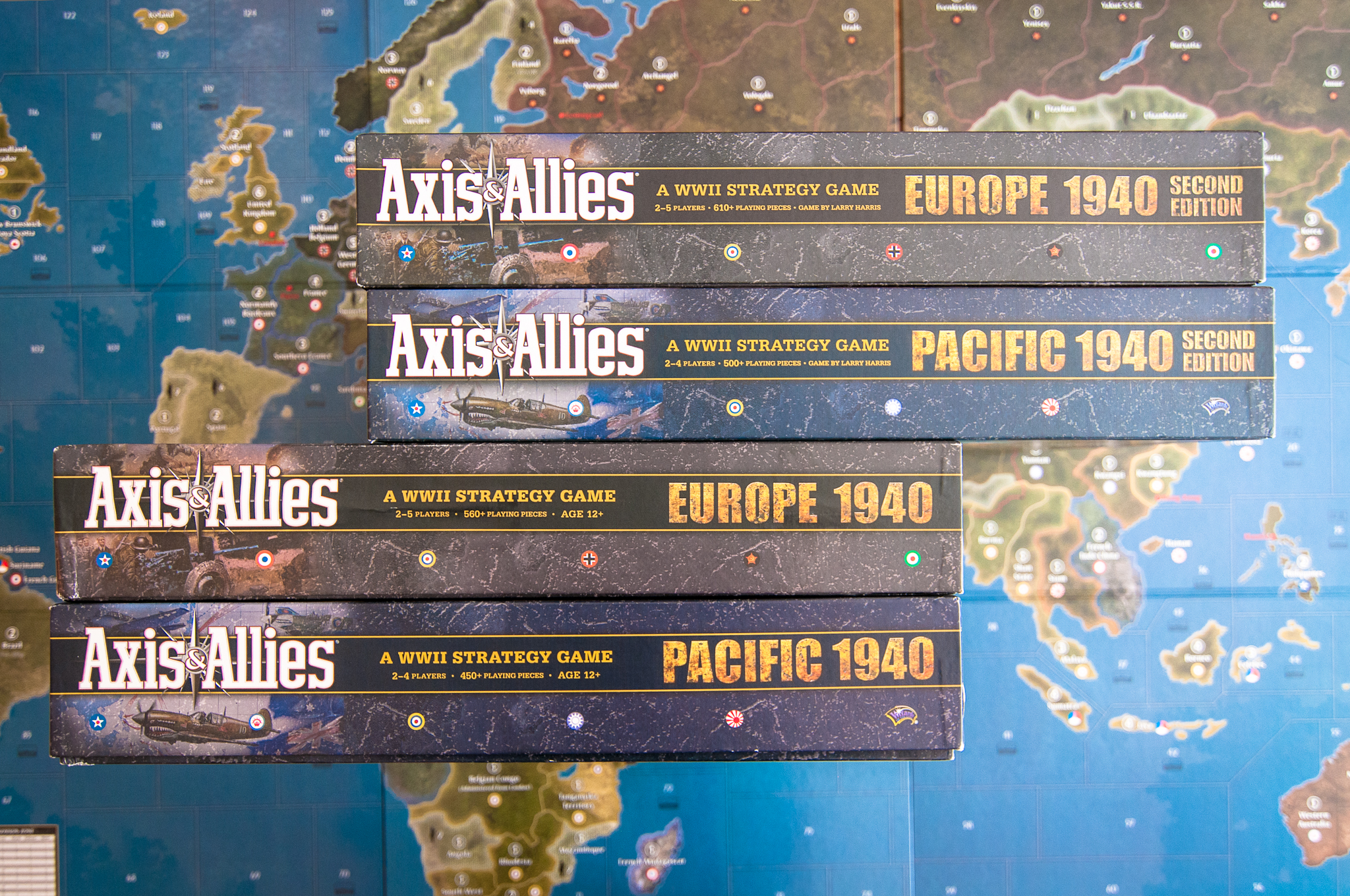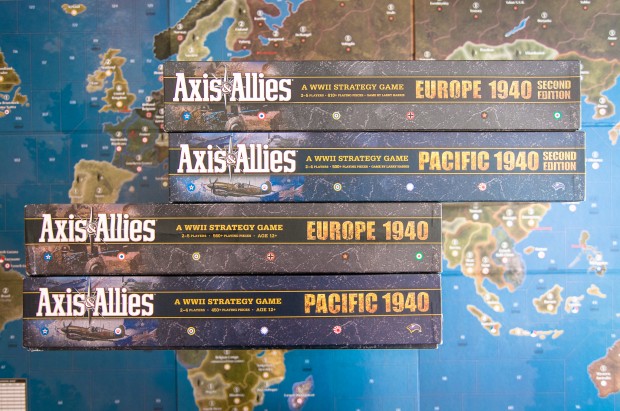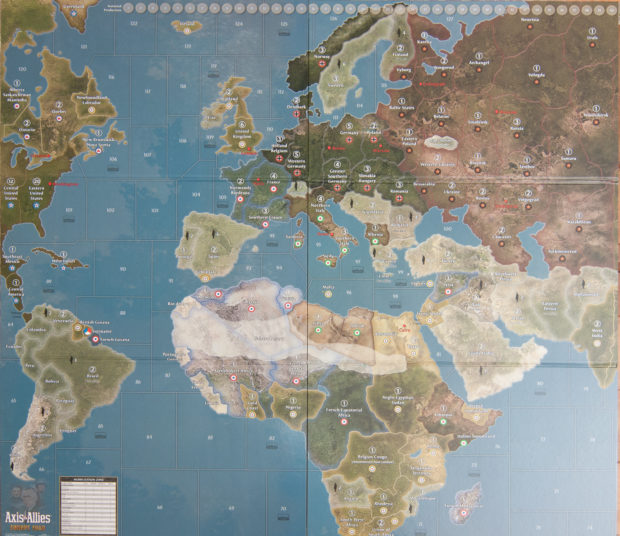The release of Axis & Allies Pacific 1940 Second Edition and Axis & Allies Europe 1940 Second Edition is nearly here. So what’s new in this edition? Will you need to buy a new copy of the game?
In short, the changes mostly revolve around the rules. The new rules are based heavily on the Axis & Allies 1940 Alpha +3 ruleset on Harris Game Design, which represents quite a few changes from the first edition. Since the map is the same, this is good news for existing owners of the game who are looking to save some money. Existing owners will only miss out on a nice rule book and the new and a ton of new pieces.
Please note the differences in this article are between the First Editions and the Second Editions of the game and not the “Alpha” rules.
Map
The map is exactly the same with the exception of a production chart running across the top of the board. The dimensions are the same, the territories are the same, some of the lines don’t quite match up the same, and some of the colors are slightly different the same.
Pieces
Second Edition games come with approximately 50 more pieces each as well as the new Antiaircraft Artillery unit for each country. There are also a several new sculpts for the units in these editions including all new unique pieces for ANZAC and Italy.
- USA
- Antiaircraft Artillery: M1 90mm
- UK
- Antiaircraft Artillery: QF 3.7 inch
- Artillery: 25 pounder
- Mechanized Infantry: Priest
- Destroyer: Saumarez
- Submarine: Truculent
- France
- Artillery: Same as USSR (152mm Howitzer)
- Antiaircraft Artillery: Same as USSR (M1939 85mm)
- Naval Transport: Same as USSR (Baltic Timber Ship)
- USSR
- Antiaircraft Artillery: M1939 85mm
- Artillery: 152mm Howitzer
- Naval Transport: Baltic Timber Ship
- ANZAC
- Infantry: new sculpt
- Artillery: BL 5.5 inch
- Antiaircraft Artillery: L/70 40mm
- Mechanized Infantry: Ram-Kangaroo
- Tank: AC1 Sentinel
- Fighter: CA-12
- Tactical Bomber: TB.Mk.1
- Strategic Bomber: PV=1
- Battleship: Warspite
- Aircraft Carrier: Majestic
- Cruiser: Same as UK (same as first edition)
- Destroyer: Tribal
- Submarine: S
- Naval Transport: Monowai
- Germany
- Antiaircraft Artillery: Flak 41 8.8cm
- Italy
- Artillery: Cannone da 75/32
- Antiaircraft Artillery: Cannone da 90/53
- Mechanized Infantry: SPA Dovunque 35
- Tank: M15/42
- Fighter: C.202
- Tactical Bomber: SM.79
- Strategic Bomber: P.108
- Battleship: Littorio
- Aircraft Carrier: Aquila
- Cruiser: Zara
- Destroyer: Soldati
- Submarine: Marconi
- Naval Transport: Iridio Mantovani
- Japan
- Antiaircraft Artillery: Type 88 75mm
- Mechanized Infantry: Type 1
Setup
The game setup has changed from First Edition to the new Second Edition games.
Take a look at the Setup Chart for Axis & Allies Europe 1940 Second Edition and the Setup Chart for Axis & Allies Pacific Second Edition.
Rules
With regard to game phases, movement, attack, and so on, the basics have not changed. Most of the units operate the same. The list below goes through nearly all of the rules changes.
Please stay tuned as this section is currently incomplete and will be continually updated over the next few days.
Antiaircraft Artillery
Gone are the days of the generic, country-neutral Antiaircraft gun. Now, each country has their own unit for defending against aircraft. These units were first introduced in the Global 1940 “Alpha” rules on Harris Game Design but, officially, the first game with them is Axis & Allies 1942 Second Edition.
At the beginning of combat each AAA gun can fire at 3 aircraft but two AAA guns cannot fire at the same aircraft. What this means is that you never roll more dice than there are attacking aircraft. For instance, if defender has 2 AAA guns and the attacker has 3 aircraft, the defender rolls three dice. Each roll of a 1 is a hit and the aircraft is removed immediately. The AAA unit may be taken as a casualty and it may not be captured. Aside from the antiaircraft capability, it has no attack and no defense value. They may only move during the non-combat phase. Therefore, when transporting AAA units on naval transports, they may only be loaded and unloaded during the non-combat movement phase.
Global Rules
Victory Conditions
The victory conditions for the Global game have changed slightly. Allied victory is roughly the same but the Axis can win with either 8 victory cities in Europe or 6 victory cities in the Pacific, as long as they control an Axis capital.
Political Situation
Several changes were made to the political situation in the game.
National Objectives
A few National Objectives were added and the wording of others were clarified.
Setup
In addition to the normal setup, add the following. The changes are underlined.
- Amur: 6 Soviet infantry
- Sakha: 6 Soviet infantry and 2 Soviet AAA
- Buryatia: 6 Soviet infantry
- Egypt: 2 ANZAC infantry and remove 1 UK infantry
- Germany: 30
- Soviet Union: 37
- Japan: 26
- United States: 52
- China: 12
- United Kingdom – Europe: 28
- United Kingdom – Pacific: 17
- Italy: 10
- ANZAC: 10
- France: 19
Additional Rules
The industrial complexes in Western US, Central US, and Eastern US start as Minor ICs and are automatically upgraded when the US enters a state of war.
If the Soviet Union attacks Korea or any Japanese controlled territory bordering Mongolia, then Mongolia will never join Soviet Union.




